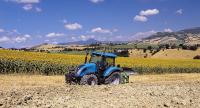
In organic farms, reduced tillage for soil conservation does not significantly decrease marketable crop yield, according to a recent Dutch study. Despite concerns of increased weed activity, especially on herbicide-free farms, reduced tilling resulted in similar or higher crop yields for six out of eight experimental crops.
Soil tillage is a practice in which farmers mechanically turn over the soil that can help control weeds and other pests while also preparing the land for seeds to be planted. Tillage has been a principal farming technique for both organic and non-organic farms over the years, however, mounting evidence that decreasing the intensity and frequency of tilling operations benefits soil health has increased the interest in reducing tillage across all farming systems.
Replacing deep plowing with shallower methods can improve healthy soil functions like reduced soil erosion and increased water absorption and can reduce climate change impacts by reducing greenhouse gas emissions. And yet, tillage also provides an important tool to control weeds, which can be especially important for organic farms where using harmful herbicides for weed control is prohibited. Weeds take up space and resources from cash crops, reducing crop yields. This study sought to examine how reduced tillage techniques can affect crop yield in the long-term.
This study was conducted in Dutch fields that had been organically maintained and experimentally controlled for six years prior to the start of the experiment. Researchers planted crops in a 4-year crop rotation, meaning that each field would only have the same specific crop every fourth year; crop rotations help break pest and disease cycles, improving cash crop yields. Fields were managed for 10 years, comparing three tillage treatments:
- Conventional tillage (CT), which plowed 23-25cm deep.
- Reduced tillage (RT), which plowed 18-20 cm deep and less frequently than CT.
- Reduced tillage with subsoiling (RTS), identical to RT with the addition of subsoiling, a technique that breaks up deep soil without rotating it.
Additionally, each treatment had individualized cover crops and tilling schedules, optimized for the tillage method as per past studies.
Four of eight crops–potatoes, spring wheat, fava beans, and pumpkin–had no significant difference in crop yield between conventional and reduced tillage treatments. Oats and grass clover had increased marketable yields under RT (up 12.1% and 11% respectively) and RTS (up 15% and 9.3% respectively) compared to CT, indicating that maintaining soil health can be significantly beneficial to these crops.
Compared to CT, cabbage yields were lower in RT (down 5.1%) and carrot yields were lower in both RT and RTS (down 13.2% and 15.2% respectively). The researchers hypothesized that the residue of the RT and RTS cover crops, which have been shown to have inhibitory effects to carrot growth, could have led to this drop in carrot yield. This effect was not present in CT fields because its soil was left empty between fall and spring while the RT and RTS fields hosted the suppressive white clover and vetch plants 4-6 weeks before carrot sowing.
The switch to organic farming can be difficult, especially for non-organic farmers using reduced-tillage or no-till with herbicides to control weeds. Organic farmers must be innovative and fine-tune their practices to control weeds and pests without chemicals and without too much soil disturbance. However, this study demonstrates that organic farms can maintain healthy soil while harvesting high yields of cash crops even with reduced-tillage techniques.
Source: The Organic Center



